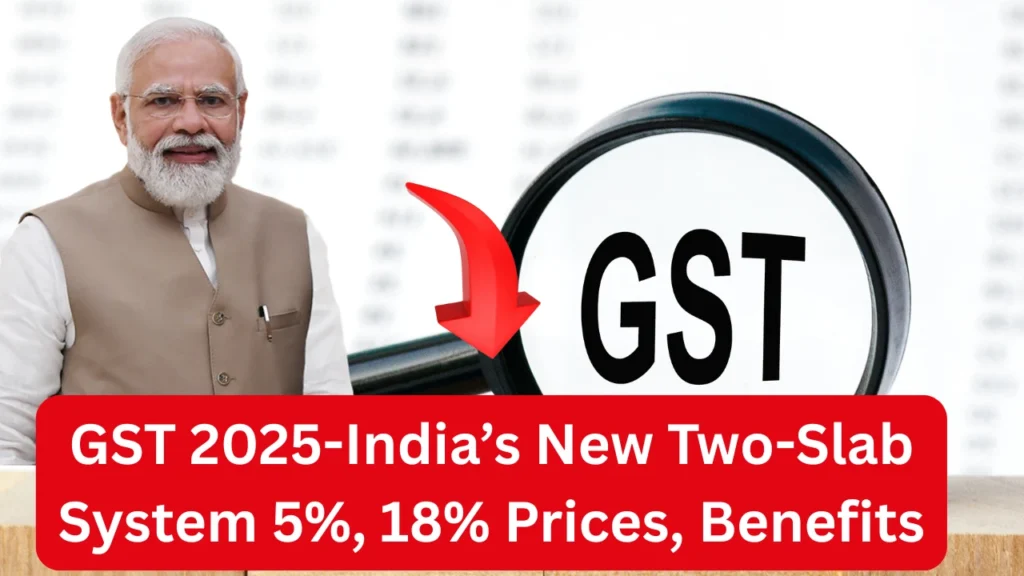India moves into a new phase of indirect taxation with GST 2025. The reform aims to make pricing simpler for buyers and compliance easier for businesses. Under the plan, the four-slab structure (5%, 12%, 18%, 28%) gives way to two main slabs 5% and 18% with a 40% rate reserved for a short list of luxury or sin goods. The promise is straight: leaner slabs, fewer disputes, quicker billing, and a more predictable price tag for everyday items.
The rollout timeline points to before Diwali 2025. Discussions with states sit in August–September, followed by a special Council sitting to finalise the switch. Once the Council clears the format, the twin-slab structure goes live nationwide.
Income Tax Rules 2025-New Slabs, Deductions and Filing Deadlines Unveiled
GST 2025 Two-Slab System Explained-5% and 18% Rates
| Point | Quick Facts |
|---|---|
| Core reform | GST 2025 shifts from four slabs to two standard slabs: 5% and 18% |
| Legacy change | Current 12% items move to 5%; current 28% items move to 18% |
| Special rate | A separate 40% rate applies to a small list of luxury or sin goods (e.g., tobacco, some gaming categories) |
| Target date | Rollout before Diwali 2025, after state consultations and a special GST Council meeting |
| Why it matters | Lower prices on daily-use goods and simpler tax filing for businesses |
| Economy view | Possible lift in growth, lower inflation pressure, and stronger demand |
| Sectors in focus | Food, FMCG, hospitality, garments, footwear, automobiles, consumer durables, EVs |
| Who benefits | Households from cheaper essentials; MSMEs from clarity and easier compliance |

Old slabs versus the new GST 2025 structure
The earlier GST era builds four slabs to balance revenue needs and affordability. Over time, this grid turns complex for invoices, rate classification, and ITC (input tax credit) reconciliations. GST 2025 cleans the grid:
- 5% slab becomes the home for present 12% items (daily-use and mass-market categories).
- 18% slab absorbs present 28% items (consumer durables and several mobility products).
- 40% special rate continues for a small list of luxury or sin goods.
This structure cuts confusion at billing counters. It also reduces borderline disputes where a product sits between two close slabs.
NHPC Non Executive Recruitment 2025 Start-Apply Online 248 Posts
What shifts into 5%: relief on household budgets
Goods and services presently under 12% shift down to 5%. That bucket includes:
- Packed and processed foods, ready-to-eat items
- Milk-based products in processed form
- Restaurant and hotel dining in standard categories
- Garments and footwear in mass-market price bands
- Packaging materials used widely across FMCG and retail
The practical result shows up in grocery bills, small-ticket apparel, and eating-out costs. Families track lower outflow on essentials and discretionary food spends, especially in urban clusters where dine-out and delivery form a regular habit.
What moves to 18%: big-ticket value becomes better
Many present 28% items move to 18% under GST 2025:
- Small cars and two-wheelers, including electric scooters and bikes
- White goods such as ACs, refrigerators, washing machines
- Premium packed foods and several travel/hospitality bookings
These items become easier to buy and finance. A lower tax load often pushes faster inventory turns at dealerships and showrooms. It also helps rural and small-town buyers who track monthly EMIs closely.
The 40% list: a narrow, special-rate pocket
GST 2025 reserves a 40% rate for a short list of luxury/sin goods. This pocket protects public health and revenue goals while keeping routine consumption cheap enough for households. The list stays narrow and distinct, so rate disputes do not spill into mass-market goods.
How GST 2025 impacts businesses and MSMEs
Billing and classification become simpler with two slabs. Fewer borderline calls mean fewer notices and faster vendor reconciliations. IT systems need one-time reconfiguration, but ongoing compliance becomes easier. With 12% moving down to 5% and 28% moving down to 18%, pricing strategy gains predictability. Retailers can re-print shelf tags and run nationwide promotions with less region-by-region confusion.
For MSMEs, the twin-slab grid cuts training time for accounts staff and reduces disputes during audits. With fewer slab jumps, cash-flow planning improves, because credit notes and rate differences shrink. This clarity also strengthens supplier negotiations and helps enterprises quote cleaner rates in tenders.
LIC Senior Citizen FD Interest Rate Revised August 2025-Check New Rates
Macro picture: inflation, demand, and growth
Lower tax on daily-use goods puts money back into wallets. Households often channel that saving into a mix of staples and small upgrades, which in turn drives production and logistics. On the investment side, consumer durables and mobility categories see better demand visibility, which pushes capacity utilisation higher. The chain reaction supports growth even when external conditions remain tight.
Stock markets usually reward lower tax-induced price tags in autos, FMCG, and durables. A visible bounce often follows policy clarity. For the real economy, the sustained gain depends on how smoothly rate changes land on factory floors and billing systems.
Timeline: how the rollout takes shape
The implementation plan for GST 2025 maps a quick but orderly path:
- August–September: Formal consultations with states and fitment exercises.
- Late September: A special GST Council meeting to lock rates and notifications.
- Before Diwali 2025: Nationwide switch to the 5% and 18% twin-slab grid, with the 40% pocket for select goods.
This timeline gives trade enough time to reconfigure POS systems, revise price lists, and clear old-rate stock with proper documentation.
What consumers can do now
- Plan purchases of white goods or vehicles close to the switchover if you track savings.
- Watch store tags; ask for GST breakdown on invoices during the transition week.
- Compare finance offers; reduced tax opens better EMI options.
- Keep bills safely for warranty and service claims.
What businesses should do now
- Update ERPs and POS to reflect the two slabs and the narrow 40% pocket.
- Rework price lists and contracts with vendors and dealers; add a transition clause for delivery in the switch window.
- Communicate to customers; show before/after rate cards for trust.
- Train front-end teams so billing stays error-free on day one.
- Audit input tax credit (ITC) positions to avoid carry-forward mismatches.
Practical examples: how prices could change
- A family upgrades a 1.5-ton AC. With the rate moving from 28% to 18%, the invoice softens even after dealer margins.
- A commuter books a two-wheeler; lower GST helps the on-road figure and the EMI breaks.
- A parent buying school shoes and uniforms sees a consistent 5% rate in place of 12%, which reduces seasonal strain.
- A college student eating at quick-service restaurants pays a lower GST share in the final bill.
Actual savings vary by MRP, trade margins, and state levies outside GST (where relevant), but the structural direction stays clear.
Guardrails during transition
- Dual-pricing confusion can show up if old-MRP stock sits on shelves during the switch. Retailers should stamp revised tags fast.
- Service contracts (AMCs, subscriptions) need updated GST lines to avoid disputes.
- Credit notes and debit notes may rise briefly as parties align quantities and dates at the rate change boundary. Keep documents complete to protect ITC.
FAQs
To shift India to a simpler two-slab structure—5% and 18%—with a 40% pocket for a few luxury or sin goods. The grid becomes cleaner, bills become easier to read, and filing becomes faster.
Present 12% items move to 5%. These include packed foods, processed milk products, ready-to-eat items, garments, footwear, and many restaurant/hotel services.
Small cars, two-wheelers (including EVs), ACs, refrigerators, washing machines, and several travel/hospitality services shift to 18%.
The plan targets a launch before Diwali 2025, subject to state consultations and a special GST Council meeting.
It applies to a short list of luxury/sin categories. The idea is to maintain a public-interest check on a few items while keeping mass-market goods cheaper.
GST 2025 sets a cleaner lane for both consumers and businesses. Households gain from lower GST on daily-use items and a more affordable ticket for big-ticket purchases. MSMEs get simpler billing, fewer slab disputes, and tighter cash-flow planning. The economy benefits from stronger consumption and better visibility for investment. With a target rollout before Diwali 2025, the best move now is preparation: reconfigure systems, refresh price lists, and plan purchases around the switch window. A lean two-slab grid promises fewer headaches and more clarity where it matters most—the final price you pay and the tax you file.
Click here to learn more

John Michael Ramos is a blogger passionate about Government Schemes, Exams, Automobiles, and Trending News. His aim is to provide simple and authentic information.

